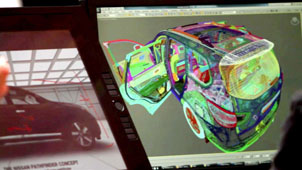Nissan Pathfinder Virtual Showroom is Latest Auto Industry Tool Powered by Kinect for Windows
[View:https://www.youtube.com/watch?v=rQVycUmeqB4&feature=g-upl]
Automotive companies Audi, Ford, and Nissan are adopting Kinect for Windows as a the newest way to put a potential driver into a vehicle. Most car buyers want to get "hands on" with a car before they are ready to buy, so automobile manufacturers have invested in tools such as online car configurators and 360-degree image viewers that make it easier for customers to visualize the vehicle they want.
Now, Kinect's unique combination of camera, body tracking capability, and audio input can put the car buyer into the driver's seat in more immersive ways than have been previously possible—even before the vehicle is available on the retail lot!
The most recent example of this automotive trend is the 2013 Nissan Pathfinder application powered by Kinect for Windows, which was originally developed to demonstrate the new Pathfinder at auto shows before there was a physical car available.
Nissan quickly recognized the value of this application for building buzz at local dealerships, piloting it in 16 dealerships in 13 states nationwide.
"The Pathfinder application using Kinect for Windows is a game changer in terms of the way we can engage with consumers," said John Brancheau, vice president of marketing at Nissan North America. "We're taking our marketing to the next level, creating experiences that enhance the act of discovery and generate excitement about new models before they're even available. It's a powerful pre-sales tool that has the potential to revolutionize the dealer experience."
Digital marketing agency Critical Mass teamed with interactive experience developer IdentityMine to design and build the Kinect-enabled Pathfinder application for Nissan. "We're pioneering experiences like this one for two reasons: the ability to respond to natural human gestures and voice input creates a rich experience that has broad consumer appeal," notes Critical Mass President Chris Gokiert. "Additionally, the commercial relevance of an application like this can fulfill a critical role in fueling leads and actually helping to drive sales on site."
Each dealer has a kiosk that includes a Kinect for Windows sensor, a monitor, and a computer that’s running the Pathfinder application built with the Kinect for Windows SDK. Since the Nissan Pathfinder application first debuted at the Chicago Auto Show in February 2012, developers made several enhancements, including a new pop-up tutorial, and interface improvements, such as larger interaction icons and instructional text along the bottom of the screen so a customer with no Kinect experience could jump right in. "In the original design for the auto show, the application was controlled by a trained spokesperson. That meant aspects like discoverability and ease-of-use for first-time users were things we didn’t need to design for," noted IdentityMine Research Director Evan Lang.
Now, shoppers who approach the Kinect-based showroom are guided through an array of natural movements—such as extending their hands, stepping forward and back, and leaning from side to side—to activate hotspots on the Pathfinder model, allowing them to inspect the car inside and out.
 The project was not, however, without a few challenges. The detailed Computer-Aided Design (CAD) model data provided by Nissan, while ideal for commercials and other post-rendered uses, did not lend itself easily to a real-time engine. "A lot of rework was necessary that involved 'retopolgizing' the mesh," reported IdentityMine’s 3D Design Lead Howard Schargel. "We used the original as a template and traced over to get a cleaner, more manageable polygon count. We were able to remove much more than half of the original polygons, allowing for more fluid interactions and animations while still retaining the fidelity of the client's original model."
The project was not, however, without a few challenges. The detailed Computer-Aided Design (CAD) model data provided by Nissan, while ideal for commercials and other post-rendered uses, did not lend itself easily to a real-time engine. "A lot of rework was necessary that involved 'retopolgizing' the mesh," reported IdentityMine’s 3D Design Lead Howard Schargel. "We used the original as a template and traced over to get a cleaner, more manageable polygon count. We were able to remove much more than half of the original polygons, allowing for more fluid interactions and animations while still retaining the fidelity of the client's original model."
And then, the development team pushed further. "The application uses a dedicated texture to provide a dynamic, scalable level of detail to the mesh by adding or removing polygons, depending on how close it is to the camera,” explained Schargel. “It may sound like mumbo jumbo—but when you see it, you won't believe it."
You can see the Nissan Pathfinder app in action at one of the 16 participating dealerships or by watching our video case study.
Kinect for Windows Team
Key Links